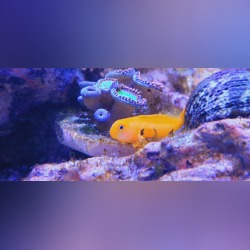Info
Enchelyurus flavipes Peters, 1868
The Yellowtail Blenny has a characteristic yellow dorsal fin and a jet black body. It is peaceful and should be kept with other peaceful fish.
Socialisation.
However, Enchelyurus flavipes can behave aggressively towards other Blenny species, Gobys, Fire Sword Gobies and other similarly shaped fish. So there are problems with fish that are similar to it. It also attacks Tridacna (giant clams), which may lead to the death of the clam.
At first glance it can be confused with the similarly coloured Bicolour Blenny (Ecsenius bicolor), but they can be easily distinguished.
Enchelyurus flavipes needs enough stones to be able to hide, sit on them and observe the aquarium, as well as to be able to scour the stones for edibles.
Food:
Enchelyurus flavipes grows up to 10 cm in size. The yellowtail blenny needs macroalgae food and dried algae 1-2 times a week. It should receive a balanced diet with meaty food, but also vegetable food.
Enchelyurus flavipes should accept any food overall and not be picky.
Aquarium equipment:
Some sources recommend an aquarium cover to prevent the Blenny from jumping out, but we cannot say whether this is necessary.
Breeding information:
Adults inhabit shallow coral reefs . They are oviparous, eggs are adhesive and attached to the substrate. Larvae live planktonic and are often found in shallow coastal waters. The male guards the attached eggs in the burrow.
Interesting courtship behaviour and mating colouration of the male.
Has already been bred by Ellen Thaler (literature reference).
The water temperature influences the spawning period (with a difference of e.g. 1°C, the difference can be ± 2-3 days) and, in the case of gonochoristic (separate-sex) fish or shrimps, the sex. If the temperature is below the usual regional temperature, mainly female larvae will hatch from the clutch, above this temperature mainly male larvae will hatch. Furthermore, the aquarium conditions (e.g. light duration, density) can also influence the sex.
The spawning size or the number of larvae depends on several factors - age and condition of the parents, water conditions, food, stress factors.
Pair formation:
A pairing has been successful several times with animals of different sizes, whereby the size difference should be at least 2 cm and the larger fish had max. 7 - 8 cm. In the beginning it can get rough, but this subsides after approx. 2 - 4 weeks. It is important that suitable caves are available for the smaller fish.
If suitable caves are available, in which there should be room for both, then fish spawn are regularly glued to the walls there.
Jumping guard
A jumping guard prevents (nocturnal) fish from jumping out.
Wrasses, blennies, hawkfishs and gobies jump out of an unprotected tank in fright if their night rest is disturbed, unfortunately these jumpers are found dried up in the morning on carpets, glass edges or later behind the tank.
https://www.korallenriff.de/en/article/1925_5_Jump_Protection_Solutions_for_Fish_in_the_Aquarium__5_Net_Covers.html
A small night light also helps, as it provides the fish with a means of orientation in the dark!
The Yellowtail Blenny has a characteristic yellow dorsal fin and a jet black body. It is peaceful and should be kept with other peaceful fish.
Socialisation.
However, Enchelyurus flavipes can behave aggressively towards other Blenny species, Gobys, Fire Sword Gobies and other similarly shaped fish. So there are problems with fish that are similar to it. It also attacks Tridacna (giant clams), which may lead to the death of the clam.
At first glance it can be confused with the similarly coloured Bicolour Blenny (Ecsenius bicolor), but they can be easily distinguished.
Enchelyurus flavipes needs enough stones to be able to hide, sit on them and observe the aquarium, as well as to be able to scour the stones for edibles.
Food:
Enchelyurus flavipes grows up to 10 cm in size. The yellowtail blenny needs macroalgae food and dried algae 1-2 times a week. It should receive a balanced diet with meaty food, but also vegetable food.
Enchelyurus flavipes should accept any food overall and not be picky.
Aquarium equipment:
Some sources recommend an aquarium cover to prevent the Blenny from jumping out, but we cannot say whether this is necessary.
Breeding information:
Adults inhabit shallow coral reefs . They are oviparous, eggs are adhesive and attached to the substrate. Larvae live planktonic and are often found in shallow coastal waters. The male guards the attached eggs in the burrow.
Interesting courtship behaviour and mating colouration of the male.
Has already been bred by Ellen Thaler (literature reference).
The water temperature influences the spawning period (with a difference of e.g. 1°C, the difference can be ± 2-3 days) and, in the case of gonochoristic (separate-sex) fish or shrimps, the sex. If the temperature is below the usual regional temperature, mainly female larvae will hatch from the clutch, above this temperature mainly male larvae will hatch. Furthermore, the aquarium conditions (e.g. light duration, density) can also influence the sex.
The spawning size or the number of larvae depends on several factors - age and condition of the parents, water conditions, food, stress factors.
Pair formation:
A pairing has been successful several times with animals of different sizes, whereby the size difference should be at least 2 cm and the larger fish had max. 7 - 8 cm. In the beginning it can get rough, but this subsides after approx. 2 - 4 weeks. It is important that suitable caves are available for the smaller fish.
If suitable caves are available, in which there should be room for both, then fish spawn are regularly glued to the walls there.
Jumping guard
A jumping guard prevents (nocturnal) fish from jumping out.
Wrasses, blennies, hawkfishs and gobies jump out of an unprotected tank in fright if their night rest is disturbed, unfortunately these jumpers are found dried up in the morning on carpets, glass edges or later behind the tank.
https://www.korallenriff.de/en/article/1925_5_Jump_Protection_Solutions_for_Fish_in_the_Aquarium__5_Net_Covers.html
A small night light also helps, as it provides the fish with a means of orientation in the dark!







 Rohleder
Rohleder






